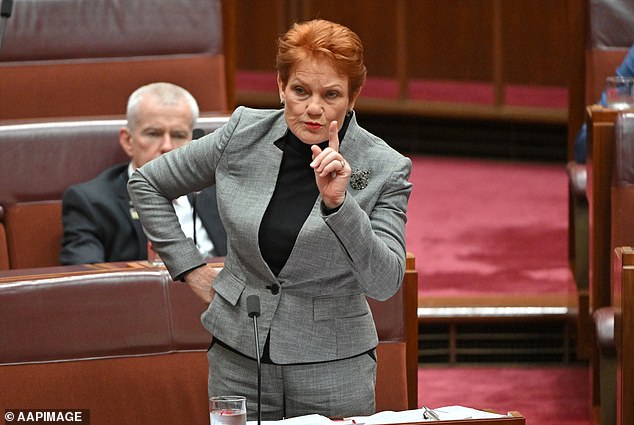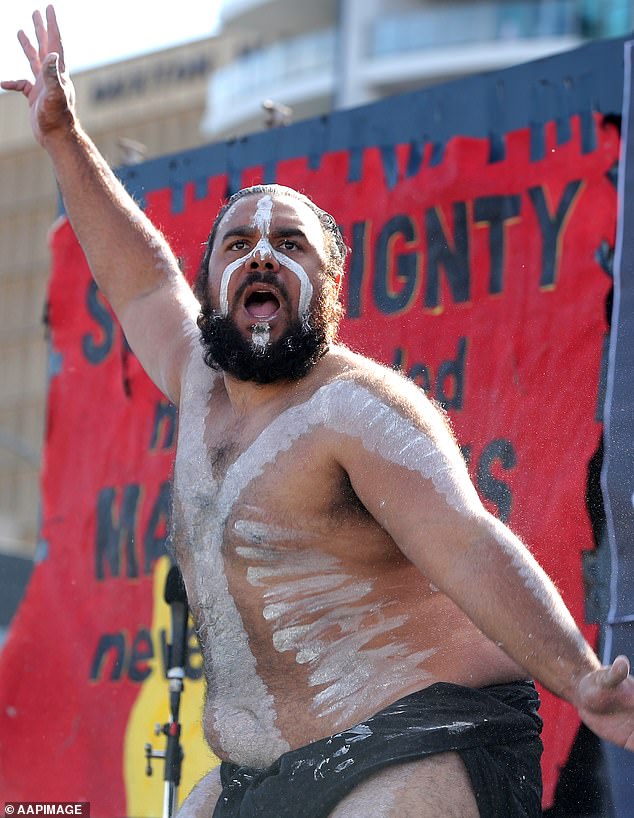Stunning map shows the extent of Native Title control in Australia – as Labor launches inquiry into ‘inequality and unfairness’ around the legislation
Native Title, a legal recognition of Aboriginal rights over a specific area, will cover 60 percent of Australia’s landmass over the next 15 years – as Labor announces an inquiry into the ‘inequality and unfairness’ of the legislation.
Indigenous rights holders can receive compensation for things that the government has done to prevent them from exercising their rights, such as building a bridge or a road.
A map from the National Native Title Tribunal shows that almost 50 percent of Australia is currently under native title. The sections are divided into dark and light green to distinguish between ‘exclusive’ and ‘non-exclusive’ zones.
A further 12 percent of the land is assessed for native title, with these areas coded in blue spots or stripes.
That means native title will cover 60 percent of Australia’s landmass within the next fifteen years.
However, less than nine percent of the indigenous population are members of an indigenous business and only half of these businesses generate money thanks to strict laws governing how the land can be used, according to the Australian Financial Statement.
On Tuesday, Attorney General Mark Dreyfus announced a $550,000 investigation into the Native Title Act, with the Australian Law Reform Commission tasked with identifying any “inequality, unfairness or weaknesses” in the legislation.
A stunning map has revealed that native title extends across half of Australia, with more claims currently being assessed in other parts of the country
It is important to note that native title can only be claimed for Crown land and does not apply to privately owned properties.
When a native title provision specifies ‘exclusive’ rights, it means that the indigenous group has exclusive ownership and control of the area in question, to the exclusion of all others, including government agencies and non-indigenous individuals or entities.
Non-exclusive native title in Australia grants indigenous groups shared rights and interests in land without exclusive control.
It can grant native title holders the right to local cultural practices, such as the right to live in the area, hunt, fish, gather food or teach the laws and customs of the land.
However, it does not give them any rights to minerals: those rights are reserved to the Crown.

Less than nine percent of the indigenous population are members of an indigenous business and only half of these businesses generate money thanks to strict laws governing how the land can be used.

Shadow Indigenous Affairs Minister Jacinta Nampijinpa Price (pictured) has called for reform of the Native Title Act for ‘land-rich, poverty-stricken’ indigenous communities
And because their rights are tied to traditional laws and customs, they would not be able to build a casino like the First Nations people in America.
To claim native title, it is necessary to demonstrate an enduring connection to the land through pre-European tribal laws and customs.
Claims are registered with the National Native Title Tribunal and resolved by courts including the Federal Court or the Supreme Court and the State Supreme Courts.
After the investigation was announced, Shadow Indigenous Affairs Minister Jacinta Nampijinpa Price called for reform of the Native Title Act for “land-rich, poverty-stricken” indigenous communities.
“In terms of native title, although it was well intentioned, and it’s all in good fun to, you know, have access to your land as a traditional owner for fishing and hunting. It was very limited in terms of what else Indigenous Australians could do,” Senator Price told Sky News.
‘Ideas such as economic development, economic independence, the opportunity to generate wealth from your own land. It was initially a very limited scope to be able to do that.”
She added: “I’ve always said that traditional owners, you know, are land rich and poverty-stricken, and should be able to create jobs on their own, on the land, rather than being perpetually dependent on prosperity. and on the government.
“We are essentially landlocked in the way we can and cannot use our land.”
However, not everyone agrees.
Last year, Senator Pauline Hanson pushed for a royal commission into native title, but her bid was rightly voted down, with only five other senators supporting the motion.
She argued that two-thirds of Australia could potentially be under the control of less than two percent of the population under Indigenous law.
“Under current law, there is an infinite period in which claims can be made,” she explained.
“That means that groups will still be able to make claims in a hundred years.”

Senator Pauline Hanson (pictured) has previously argued that two-thirds of Australia could potentially be under the control of less than two percent of the population under native title legislation.
She said that by removing federal funding from respondents but continuing to provide money to those claiming native title, the Albanian government has created a very uneven playing field.
“There are many thousands of these native titles and other land claims across Australia,” she told Daily Mail Australia last September.
“I suspect that many people living in the yet-to-be-determined areas do not even realize that they are at risk of their community becoming under native title.
‘Native title claimants have all their legal costs fully funded by the Australian Government, but not by the organizations charged with responding to these claims, because Labor has abolished the Native Title Respondent Funding Scheme.
“So if your community falls under a native title claim, the government will fund it with your taxes.”
She said two-thirds of Australia could potentially be controlled by less than two percent of the population because native title claimants must meet a stricter standard to qualify than those claiming indigenous heritage.
‘Indigenous rights holders receive direct income in the form of mining rights and other uses of land under their control.
“These are just more examples – along with the Voice to Parliament – of the Albanian Labor government treating Australians unequally on the basis of race.
‘From the beginning of my political career, I have addressed this unequal treatment based on race. I will always fight for equality for all Australians.”
Meanwhile, a decade-long feud over two Indigenous title claims is coming to an end, with First Nations traditional owners seeking ownership of 7,800 square kilometers of Australia.
The Barada Kabalbara Yetimalara people are bidding for native titles for two areas in Central Queensland, with the Federal Court of Australia set to rule soon.
Local media reported that they had won the legal battle, but the Federal Court has confirmed that a final decision has yet to be made.

On Tuesday, Attorney General Mark Dreyfus announced a $550,000 investigation into the Native Title Act, with the Australian Law Reform Commission tasked with identifying any “inequality, unfairness or weaknesses” in the legislation. An Aboriginal protester is pictured at a rally in Perth
One parcel covers over 7,512 km2 between Sarina and Rockhampton, while the second covers 294 km2 of land and water north of Rockhampton.
The native title applications were first submitted in July 2013.
They are the first in several years to hit the Isaac region, west of Mackay.
Native title differs from land rights, which only exist under laws in NSW and NT.
Land rights mean that a local land council can claim ownership of unused or misused Crown land as compensation for historical dispossession.
These claims are assessed by government authorities.
Both land rights and native property rights can coexist on a piece of land, and they can even bring traditional owners into conflict.
Traditional owners have acquired land title to 50 percent of the Northern Territory, including 85 percent of the coastline.
More than 3,000 successful land rights claims have been made in NSW, but almost 40,000 have yet to be assessed.
